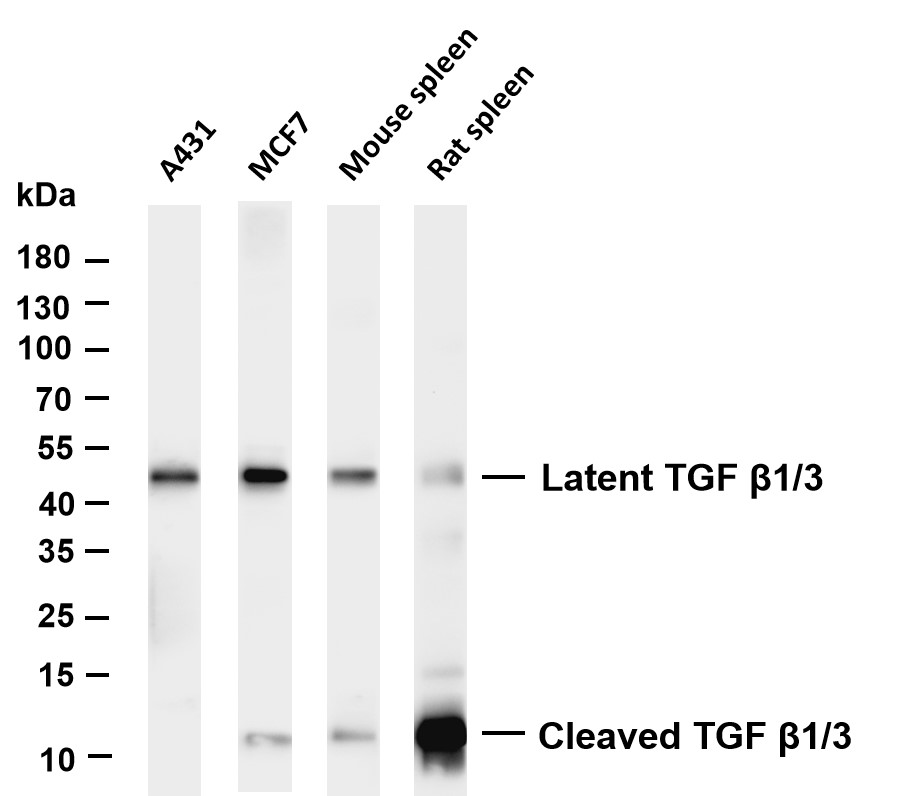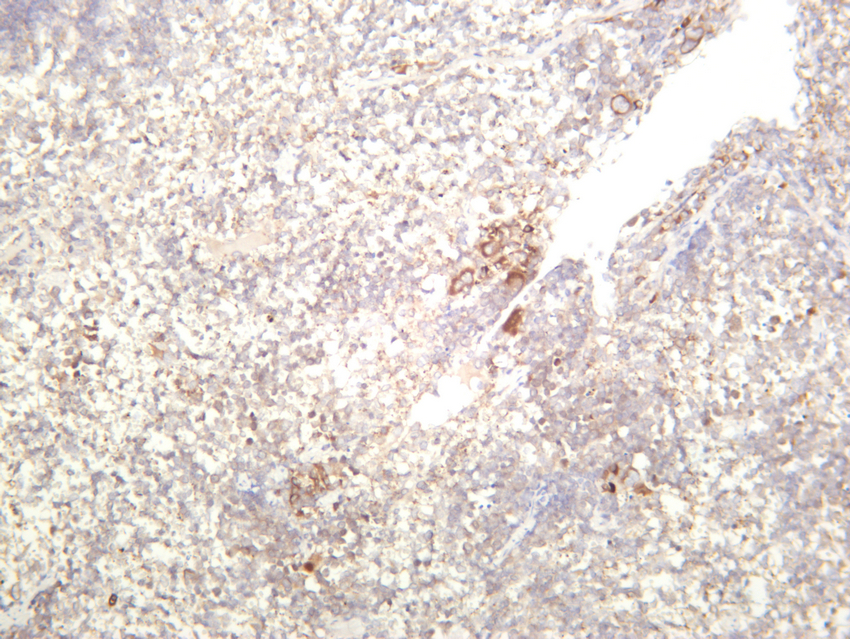TGF β1/3 (PT0402R) PT® Rabbit mAb
- Catalog No.:YM8247
- Applications:WB;IF;IP;ELISA
- Reactivity:Human; Mouse; Rat;
- Target:
- TGFB1\TGFB3
- Fields:
- >>MAPK signaling pathway;>>Cytokine-cytokine receptor interaction;>>FoxO signaling pathway;>>Cell cycle;>>Cellular senescence;>>TGF-beta signaling pathway;>>Osteoclast differentiation;>>Hippo signaling pathway;>>Th17 cell differentiation;>>Intestinal immune network for IgA production;>>Relaxin signaling pathway;>>Non-alcoholic fatty liver disease;>>AGE-RAGE signaling pathway in diabetic complications;>>Leishmaniasis;>>Chagas disease;>>Malaria;>>Toxoplasmosis;>>Amoebiasis;>>Tuberculosis;>>Hepatitis B;>>Human T-cell leukemia virus 1 infection;>>Pathways in cancer;>>Proteoglycans in cancer;>>Colorectal cancer;>>Renal cell carcinoma;>>Pancreatic cancer;>>Chronic myeloid leukemia;>>Hepatocellular carcinoma;>>Gastric cancer;>>Inflammatory bowel disease;>>Rheumatoid arthritis;>>Hypertrophic cardiomyopathy;>>Dilated cardiomyopathy;>>Diabetic cardiomyopathy
- Gene Name:
- TGFB1 TGFB3
- Protein Name:
- Transforming growth factor beta-1 proprotein;Latency-associated peptide(LAP);Transforming growth factor beta-1(TGF-beta-1);Transforming growth factor beta-3 proprotein;Transforming growth factor beta-
- Human Gene Id:
- 7040;7043
- Human Swiss Prot No:
- P01137;P10600
- Mouse Gene Id:
- 21803
- Mouse Swiss Prot No:
- P04202;P17125
- Rat Gene Id:
- 59086;25717
- Rat Swiss Prot No:
- P17246;Q07258
- Specificity:
- endogenous
- Formulation:
- PBS, 50% glycerol, 0.05% Proclin 300, 0.05%BSA
- Source:
- Monoclonal, rabbit, IgG, Kappa
- Dilution:
- IHC 1:1000-1:4000;WB 1:500-1:2000;IF 1:200-1:1000;ELISA 1:5000-1:20000;IP 1:50-1:200;
- Purification:
- Protein A
- Storage Stability:
- -15°C to -25°C/1 year(Do not lower than -25°C)
- Other Name:
- Transforming growth factor beta-1 proprotein;Latency-associated peptide(LAP);Transforming growth factor beta-1(TGF-beta-1);Transforming growth factor beta-3 proprotein;Transforming growth factor beta-3 (TGF-beta-3);
- Molecular Weight(Da):
- 44kD
- Observed Band(KD):
- 44kD,13kD
- Background:
- This gene encodes a secreted ligand of the TGF-beta (transforming growth factor-beta) superfamily of proteins. Ligands of this family bind various TGF-beta receptors leading to recruitment and activation of SMAD family transcription factors that regulate gene expression. The encoded preproprotein is proteolytically processed to generate a latency-associated peptide (LAP) and a mature peptide, and is found in either a latent form composed of a mature peptide homodimer, a LAP homodimer, and a latent TGF-beta binding protein, or in an active form consisting solely of the mature peptide homodimer. The mature peptide may also form heterodimers with other TGF-beta family members. This protein is involved in embryogenesis and cell differentiation, and may play a role in wound healing. Mutations in this gene are a cause of aortic aneurysms and dissections, as well as familial arrhythmogenic
- Function:
- TGF-beta-1 proprotein: Precursor of the Latency-associated peptide (LAP) and TGF-beta-1 chains, which constitute the regulatory and active subunit of TGF-beta-1, respectively.; [Latency-associated peptide]: Required to maintain the TGF-beta-1 chain in a latent state during storage in extracellular matrix . Associates non-covalently with TGF-beta-1 and regulates its activation via interaction with 'milieu molecules', such as LTBP1, LRRC32/GARP and LRRC33/NRROS, that control activation of TGF-beta-1 . Interaction with LRRC33/NRROS regulates activation of TGF-beta-1 in macrophages and microglia (Probable). Interaction with LRRC32/GARP controls activation of TGF-beta-1 on the surface of activated regulatory T-cells (Tregs) . Interaction with integrins (ITGAV:ITGB6 or ITGAV:ITGB8) results in distortion of the Latency-associated peptide chain and subsequent release of the active TGF-beta-1;[TG
- Subcellular Location:
- Secreted
- Expression:
- TGF β1:Highly expressed in bone (PubMed:11746498, PubMed:17827158). Abundantly expressed in articular cartilage and chondrocytes and is increased in osteoarthritis (OA) (PubMed:11746498, PubMed:17827158). Colocalizes with ASPN in chondrocytes within OA lesions of articular cartilage (PubMed:17827158).
- June 19-2018
- WESTERN IMMUNOBLOTTING PROTOCOL
- June 19-2018
- IMMUNOHISTOCHEMISTRY-PARAFFIN PROTOCOL
- June 19-2018
- IMMUNOFLUORESCENCE PROTOCOL
- September 08-2020
- FLOW-CYTOMEYRT-PROTOCOL
- May 20-2022
- Cell-Based ELISA│解您多样本WB检测之困扰
- July 13-2018
- CELL-BASED-ELISA-PROTOCOL-FOR-ACETYL-PROTEIN
- July 13-2018
- CELL-BASED-ELISA-PROTOCOL-FOR-PHOSPHO-PROTEIN
- July 13-2018
- Antibody-FAQs
- Products Images

- Various whole cell lysates were separated by 4-20% SDS-PAGE, and the membrane was blotted with anti-TGF β1/3 (PT0402R) antibody. The HRP-conjugated Goat anti-Rabbit IgG(H + L) antibody was used to detect the antibody. Lane 1: A431 Lane 2: MCF7 Lane 3: Mouse spleen Lane 4: Rat spleen Predicted band size: 44kDa Observed band size: 44,13kDa

- Mouse spleen was stained with anti-TGF β1/3 (PT0402R) rabbit antibody

- Rat spleen was stained with anti-TGF β1/3 (PT0402R) rabbit antibody



